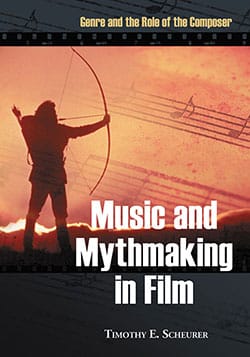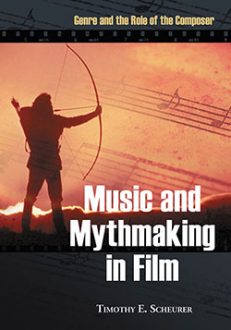Music and Mythmaking in Film
Genre and the Role of the Composer
$35.00
In stock
About the Book
This work studies the conventions of music scoring in major film genres (e.g., science fiction, hardboiled detective, horror, historical romance, western), focusing on the artistic and technical methods that modern composers employ to underscore and accompany the visual events. Each chapter begins with an analysis of the major narrative and scoring conventions of a particular genre and concludes with an in-depth analysis of two film examples from different time periods. Several photographic stills and sheet music excerpts are included throughout the work, along with a select bibliography and discography.
About the Author(s)
Bibliographic Details
Timothy E. Scheurer
Format: softcover (7 x 10)
Pages: 273
Bibliographic Info: 31 photos, notes, bibliography, discography, index
Copyright Date: 2008
pISBN: 978-0-7864-3190-8
eISBN: 978-1-4766-1069-6
Imprint: McFarland
Table of Contents
Preface 1
Part One: Major Genres 5
1 Introduction: Film Genre/Film Music 7
2 Alien Harmonies: The Science Fiction Film 48
3 Music for the Mean Streets: The Hardboiled-Detective Film 80
4 Swashbuckling Symphonies: The Historical Romance Film 105
5 The Rhythm of the Range: The Western Film Score 140
6 From Swan Lake to Synthesizers: The Music of Horror Films 176
Part Two: Gender/Genre: Heroism in Sports Films and the Woman’s Film 205
7 “The best there ever was in the game”: Musical Mythopoesis and Heroism in Film Scores of Recent Sports Movies 207
8 “I always thought I was”: Heroism and Music in Three Women’s Films 220
Discography 241
Chapter Notes 247
Bibliography 251
Index 259
Book Reviews & Awards
“recommended”—Choice; “a wonderful examination of the dynamic process of the relationship between myth, storytelling, and music in the movies. Timothy Scheurer has written a book that is desperately needed in a scholarly field that often desires to obscure its subject rather than enlighten it”—The Journal of Popular Culture; “constitutes a major study of the conventions of film scoring in a number of set genres. Particularly convincing and intriguing are the sections where Scheurer explains how narrative genre conventions have changed over time and how corresponding compositional changes can be detected…this is a major study into the composition of film music and of the kind of techniques that composers use on a daily basis, and its discussion of the relationship between film music and film genre highlights areas for further investigation in music and moving image scholarship”—Music, Sound and Moving Image.





